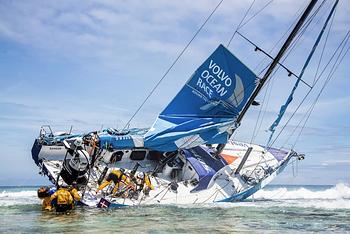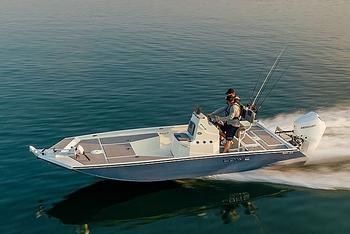Houseboats have become popular in many places due to the attraction of living so close to the water and the many different types available. Houseboats are built in an array of styles and materials, but all types will have a stateroom that serves as your bedroom, a galley, head, and saloon (those are the kitchen, bathroom, and living room if you’re not familiar with nautical lingo).
Most houseboats also have a helm, a bridge, and a navigation station, although not all of them, as we’ll explain as we explore the differences among different types of houseboats.

Main Types of Houseboats
Whether adapted for canals, lakes, or harbors, houseboats fall into two main categories: cruising and non-cruising.
Cruising houseboats
Cruising houseboats can travel on the water and are typically powered by sails or an engine. They are designed to be used in bodies of water that don’t get too rough, like lakes and rivers, and generally they are not suitable for open water or high seas. They are typically viewed as vacation vessels, although boaters sometimes choose to reside on them full time.
Cruising houseboats can be equipped with a wide range of conveniences that make them feel more like an apartment and less like a boat, but they are also popular with families who use them as a platform for a variety of water activities and excursions. They also serve as homes for some anglers who enjoy taking the comforts of home with them on leisurely fishing trips.
Non-cruising houseboats
Houseboats that remain stationary are sometimes called non-cruising or static houseboats. These boats generally lack a means of propulsion, but they are large enough and stable enough to outfit with the comforts of a land-based home. They are often moored or anchored semi-permanently at piers and marinas.
People who choose to live on the water all the time often pick a non-cruising houseboat as their residence. Non-cruising houseboats tend to be larger than cruising houseboats, with enough space for storage and custom features. They are typically plugged in at a marina with internet, electrical and other utilities.
Houseboat Categories
Canal-style houseboats
Particularly popular in Europe, canal-style houseboats, sometimes called narrowboats, have a flat bottom and deck that rises slightly upward so the front of the boat is higher than the rear of the boat. This lets the owner easily tie off on banks and docks, and use ramps or steps to disembark. Canal-style houseboats are specifically built to be used in canals and similar waterways.
Canal-style houseboats are smaller than other types, so they have less space for storage, but they are easier to move from place to place. Access to electricity and communication is achieved through a combination electrical/telephone junction box that is typically situated near the bow of the boat.

Pontoon houseboats
Houseboats built on pontoons combine the features of a pontoon boat and a typical houseboat to give boaters the best of both worlds. They are designed with two large pontoons connected by a structural grid and deck with the "house" on top. Typically made out of aluminum, they can also consist of other materials, and they make the boat stable and easy to operate. They are designed to require little maintenance, which makes these boats relatively more affordable than some other styles.
Pontoon houseboats' ease of movement makes them great for vacations and exploring new areas. They are available in a variety of sizes from small enough to comfortably hold a couple of people to large enough to contain full kitchens and bathrooms. They can also be customized with various features to make them suitable for longer excursions, including fishing, kayaking, and other water-based activities.
Floating-home houseboat
The floating-home houseboat is a stationary style commonly used for residential living. These non-cruising houseboats are designed to float on pontoons or barge-like hulls while moored to remain in one place. Often they are connected to local sewer and utility lines.
When you compare different types of houseboats, floating-home houseboats are some of the most economical and energy-efficient options available. Then again, that’s often because these houseboats have no self-propulsion or steerage capabilities.
Because these houseboats are mainly used as primary residences, they are often found in communities of like-minded individuals who enjoy life on the water. The Seattle waterfront is well known for such communities.

Catamaran-style houseboats
A catamaran-style houseboat combines the features of a catamaran and a regular houseboat to boost stability and comfort. Instead of a single hull, this design features two long narrow hulls connected by a platform on which the structure of the house sits, similar to some pontoon houseboats. The boats can be made from aluminum, fiberglass, or wood, and typically range between 30 feet and 50 feet in length.
The benefits of choosing a catamaran-style houseboat include good stability, efficient handling, and easier docking. The style is one of the most fuel-efficient types of houseboats, and they often have more storage space than other houseboat styles. There is also more room for amenities for those seeking a luxury experience.
Full-hull houseboat
A full-hull houseboat is one of the most common types of houseboat and has a solid hull made out of a single material, typically molded fiberglass, often reinforced with wood for extra strength. The superstructure, or “house,” is often built from separately molded fiberglass segments and bolted or fiberglassed to the hull. Finally, the boat is fitted out with additional mechanical boat systems plus what you’d expect to find in any house, from wiring and insulation to hardwood floors and custom decor.
Full-hull houseboats are often built with vertical dimensions that provide larger living spaces and storage spaces than other styles of houseboats of similar area. Additional storage space can be found below the deck. Various features can be added to further customize the houseboat to make it more comfortable.
Barge-style houseboats
Barge-style houseboats are some of the largest houseboats available. Boats of this style can be found in both cruising and non-cruising models. They are built with a shallow depth so that they can easily move through shallow water. They are often picked for their low maintenance requirements.
When boaters compare different types of houseboats for families, a barge-style houseboat is often chosen for its ample space. Some models accommodate up to 10 people comfortably. In addition to giving each member of the group some space, barge-style houseboats can be outfitted with amenities that make them cozier homes. Some have full kitchens and bathrooms, and some have a washer and dryer on board.

Trailerable houseboats
Trailerable houseboats are some of the smallest houseboats available and among the most versatile and affordable due to their size. However, for the same reasons, they aren’t necessarily the best boat to take the place of your current house ashore.
Long and narrow, trailerable houseboats can be towed on a trailer attached behind a powerful vehicle and stored in a large garage. Recent models like the 31-foot Lil Hobo have a catamaran hull and trailer in a fashion similar to an RV. Trailerable houseboats are constructed of aluminum, fiberglass, steel, and even wood. This style of houseboat is often used in lakes, rivers, and intracoastal waters, but is not well-equipped to handle more open water.
Once you've launched one, a trailerable houseboats is usually maneuverable, powered by one or two outboard engines, and is good for trips to out-of-the-way places. They may accommodate four people, but quarters are tight for living aboard over the long term. Smaller size means less room for amenities, so owners have to carefully consider what features to add. They also have limited storage space for your other comforts.
River houseboats
River houseboats are designed to be completely self-sufficient and are built with ample living space. They are typically chosen by families or groups of friends, with some models having a capacity of up to 20 people to enjoy an afternoon aboard. However, there are also smaller models better suited to small groups with overnight accommodations for two or four people.
River houseboats are typically constructed of fiberglass, making them sturdy vessels. They can be found in both cruising and non-cruising styles, and offer excellent accommodations with many amenities. River houseboats are available at every price point from economical to luxury, and many can be customized with additional features.

Yachts
Yachts are really the only type of "houseboat" designed to be used in more open waters, and they typically fall into the category of trawler (power) or bluewater cruiser (sail). Equipped with diesel engines and/or well-built sails, their hulls are designed to perform well in rough water and are typically made of fiberglass or, sometimes, aluminum or steel.
Some cruisers live on their yachts a full-time, but their main appeal is a high-level of fit and finish, plus the ability to literally cruise the world. Depending on their size and design, some are built with multi-level staterooms, multiple heads (bathrooms), extensive galleys, and large gathering areas. Some high-end models in the superyacht category (over 100 feet in length) also have helipads, discos, spas, and an opening transom that gives access to all manner of water toys.
Luxury houseboats
Luxury houseboats may have price tags similar to yachts in that they are usually larger than typical houseboats and are built with numerous luxury features. These often include air conditioning, dishwashers, grills, and granite countertops. They are often in the non-cruising category, parked at the water’s edge as a comfortable floating house, sometimes two-stories high.
Some are motorized, however, and may be a heavily customized vessel that started life as a working commercial boat as a shipping barge or cargo ship, on a busy waterway in a country like the U.K. or the Netherlands.
See the listings at Rightboat.com to browse our houseboats of various styles and sizes.
- Living on a Sailboat: Is it Right for You?
- The Best Boats to Live On Full Time
- Life on the Water: Living Aboard a Trawler Boat
- The Best Types of Boat to Live on After Retirement
- Sleeping on a Boat: Tips for Overnight Stays
- Is Living on a Boat Right for You? The Pros and Cons of Living on a Boat


